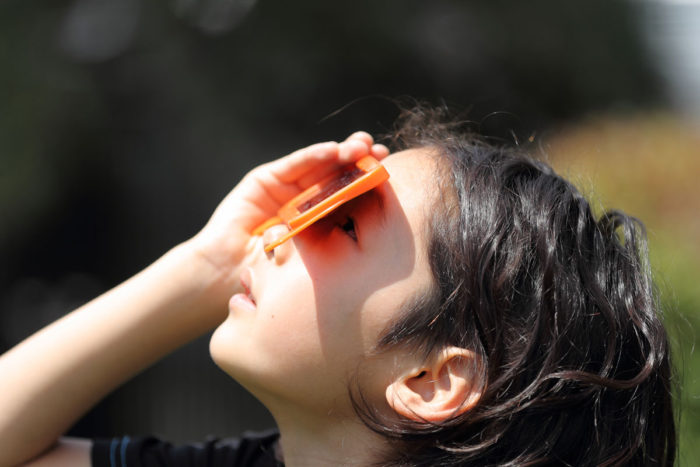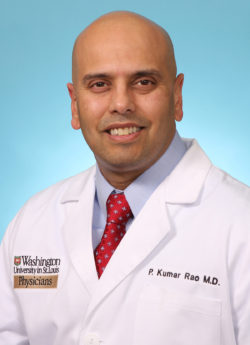Enjoy the eclipse, but protect your eyes
Ophthalmologist offers tips for safe viewing
 Getty images
Getty imagesA solar eclipse — when our view of the sun is blocked by the moon — will be visible Monday, Aug. 21. A Washington University ophthalmologist suggests those in the path of the event get in on the eclipse-watching, but the retina specialist warns adequate eye protection is essential.

A total solar eclipse — when our view of the sun is blocked by the moon — will be visible Monday, Aug. 21, within a band stretching from Oregon to South Carolina. Parts of the St. Louis area fall within that stretch. People outside of the band will be able to witness a partial solar eclipse — weather permitting, of course.
The eclipse’s partial phase will begin at 11:52 a.m. in St. Louis. Totality, for those in a position to witness it, will last from 1:16 to 1:19 p.m.; the length of time a person can witness totality will depend largely on his or her specific location, not to mention the weather. The eclipse will end at 2:44 p.m.
Retina specialist P. Kumar Rao, MD, a professor of ophthalmology and visual sciences at Washington University School of Medicine in St. Louis, said those in the path of the eclipse should get in on the watching if they’re able, but he warned that people should protect their eyes if they want to view this rare event. Here, he offers his expertise on safely viewing the eclipse.
Q: Why is it important for people to protect their eyes during an eclipse?
A: For many people, this is a once-in-a-lifetime event. It may be tempting to look directly at the sun as the moon begins to obscure the view, but no one should look at an eclipse with a naked eye or even regular sunglasses. The safest and easiest way to get a look an an eclipse is with special ISO-certified glasses that meet the ISO 12312-2 standard. They’re not expensive and are widely available. What’s special about these glasses is they act as a filter to reduce the sun’s brightness to a safe level. They also block harmful ultraviolet and infrared radiation. If you don’t get the eclipse glasses, another way to participate safely is to fashion a pinhole camera. You take a card and place a hole in it, put your back to the eclipse and hold the card up in the air so that the sunlight passes through the hole in the card. That will allow you to see a shadow of the eclipse on the ground.
Q: Are the dangers of looking at an eclipse similar to the dangers of staring directly at the sun?
A: The sun has enough light intensity to burn or damage the retina. The retina is like film in an old-fashioned camera, and you can imagine if you burn a hole in the film, you don’t get a good picture. If sunlight damages the retina, you don’t see very well. Looking directly at a very bright light source — whether it’s directly at the sun or at a solar eclipse — can damage delicate retinal tissue.
Q: Is damage to the retina from a solar eclipse akin to seeing spots after somebody takes your picture using a camera with a flash?
A: Yes, only hundreds of times worse, and with prolonged exposure, looking at the sun can lead to permanent damage. You can recover from the flash after a picture, but if you stare directly at the sun, or at a solar eclipse, it’s possible to sear your retina. What sort of damage may vary from person to person, and it may not be apparent immediately, but the consequences can be serious, including vision loss.
Q: What if people want to try to photograph the eclipse or look at it through binoculars?
A: If you are trying to photograph the eclipse or view the event through binoculars, it’s important to research what astronomy and/or photography experts have to say about how to do this most safely. Solar filters are recommended – but you want to be sure you are placing filters specifically where they need to go, thus the need to find out just what such experts recommend. This is not the sort of thing you want to try without knowing precisely what to do.

Q: Is it safe, even for a few seconds to just get a glimpse of the eclipse?
A: I wouldn’t recommend trying to sneak a peek of the partial eclipse, when the moon only partially covers the sun. What happens is people can get mesmerized by the wonder of it all and may end up staring at the sun longer than is safe. But there is a very short period of time when you can look directly at the eclipse safely. That’s during the total eclipse period, when the moon completely obscures the sun and there’s no sunlight getting through. Unfortunately, depending on where people are in the path of the eclipse, that period of time may last only a few seconds.
Q: What will you be doing during the eclipse?
A: I would be really excited about seeing this eclipse, but I’ll be taking my son to college — another once-in-a-lifetime event — and we’ll be traveling outside of the path of the eclipse. For those who will stay here in the path of the eclipse, go out and enjoy it, but do it safely.






